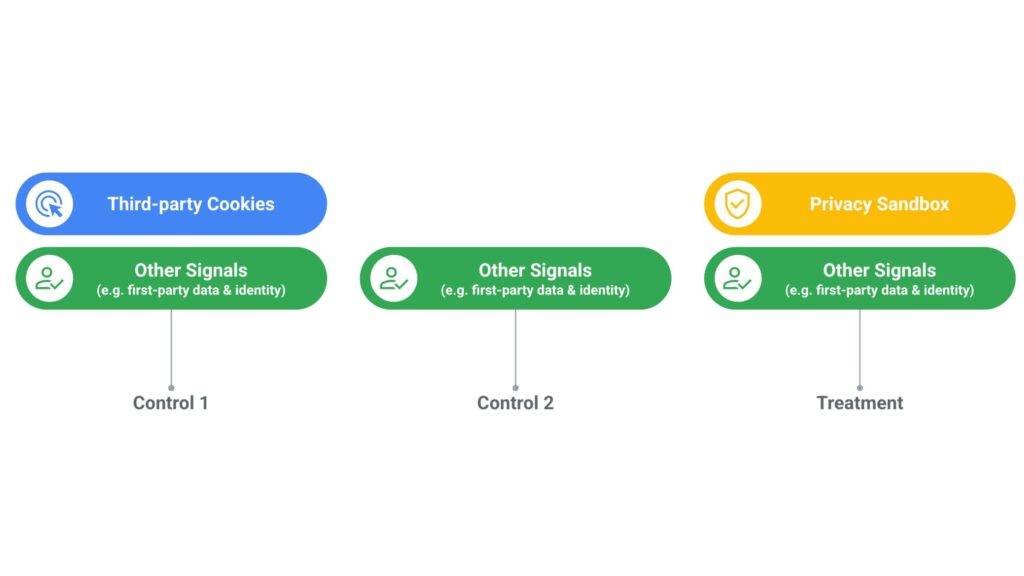After a years-long effort to make “cookie-free” happen, Google announced it’s halting third-party cookie deprecation. Experienced marketers aren’t surprised. This reversal may muddy the waters but it certainly won’t stop the real patterns at play in today’s marketing landscape.
What’s the big picture behind this latest news from Google? And how does it impact your marketing strategy? Here’s the headline: Consumers’ demand for privacy remains strong, while marketers continue to navigate an increasingly complex landscape requiring sophisticated strategies to maintain both consumer satisfaction and ROI.
How brands can make that marketing magic happen is another story. Success depends on a clear, data-driven strategy rooted in a brand’s true value, authentic connections, and a captivating consumer journey that drives action. That’s where things can get tricky.
Discover the reasons behind Google’s decision and how your marketing can continue to thrive within an even more complex landscape.
Jump To:
Google ends third-party cookie deprecation.
On Monday, Jul 22, 2024, Google announced an updated approach to privacy that keeps third-party cookies in the picture.
Third-party cookies, tiny text files stored on a user’s browser, have been making big news in the ad world for years as consumers and regulators demand stricter privacy for users online. Google has been planning to deprecate third-party cookies since 2020, but that effort ended this week.
“Instead of deprecating third-party cookies, we would introduce a new experience in Chrome that lets people make an informed choice that applies across their web browsing, and they’d be able to adjust that choice at any time.”
– Anthony Chavez, Vice President of Privacy Sandbox
This one-time prompt enables users to set a preference that will apply across all of Google’s browsing experiences. Many unknowns remain, with the announcement giving few details and no clear timeline. Here’s what Google has shared.
Privacy Sandbox APIs continue.
Google continues to strengthen its Privacy Sandbox APIs, even as third-party cookies remain on the menu. In the results of a performance experiment, Google shared key findings, including a 13% uplift for publishers on Google Ad Manager and a 3% uplift for publishers on Google AdSense. Google’s Sandbox is just one tool within a growing arsenal to ensure privacy-compliant advertising that also meets rising consumer expectations.

Proposed IP Protection for Chrome.
While third-party cookies can still be used, to avoid sharing a user’s real IP address with third parties, Google is proposing to anonymize IP addresses. This will prevent cross-site tracking, and avoid sharing a user’s real IP address with third parties beyond cookies. IP Protection would launch as a default setting for Chrome users after 2025. The testing and ultimate launch of IP Protection will be determined in coordination with regulators, such as the UK’s Competition and Markets Authority.
What’s the big picture for privacy in marketing?
Google’s announcement rings true for marketers walking the tightrope of consumers’ increasing desire for privacy and personalization and crafting multichannel marketing journeys that ultimately deliver top performance. Any marketer focused on the future knows that none of these are mutually exclusive.
Instead, only by bringing together these intricate puzzle pieces and making connections across an ever-expanding landscape (retail media networks, looking at you!) can brands even hit the mark. How well-connected is your marketing strategy to meet the needs of regulators and consumers today — and tomorrow?
Consumers want more privacy online.
While third-party cookies will continue to be of use, the reasons Google attempted to sunset them in the first place remain the same. Consumers want more privacy online, and marketers will need to increase privacy-first marketing solutions to not only keep customers happy, but ultimately deliver smarter marketing that performs better.
“Deprecating third-party cookies was never the goal – the goal has always been to improve privacy practices and provide users with more visibility into and control over what personal data is stored and used.
Google’s shift is an opportunity to build more authentic, trust-based relationships with users.
By evolving data collection practices and leveraging advanced targeting techniques, we can navigate these changes with minimal disruption and continue to deliver personalized, impactful marketing experiences.”
– Greg Harbison, VP, Digital Strategy
Over time, marketers will continue to be less reliant on cookied advertising, and Google’s announcement to put choice into consumers’ hands, simply means a longer and more confusing timeline to arrive at the inevitable. This isn’t new. Safari and other browsers have already moved forward with reducing the usefulness of cookies. Surveys show about 20% of users reject cookies.
A more private web is underway with or without Google’s cookie deprecation. Consumer and regulatory momentum towards stricter control continues as marketers work to ensure compliance across an ever-expanding network of marketing channels and solutions.

“Google’s decision doesn’t remove the need for advertisers to move away from traditional browser-based tracking.
With 35% of the market using browsers other than Chrome, and close to 20% of consumers rejecting cookies when given the option, advertisers who rely solely on browser-based tracking are losing out on valuable data.
Even in light of Google’s decision, Amsive continues to recommend that all advertisers adopt server-side tracking in order to own their tracking data and control what data they share with the ad platforms.”
– James Connell, SVP, Digital Media
While Google’s decision does make targeting easier, focusing your targeting on a custom-created audience from Amsive is way better than relying on other vendor audiences.
Cookies or not, what must marketers focus on? A stronger audience strategy.
Your marketing decision-making is only as powerful as the audience intelligence, analytics, and strategy behind it. Improving the efficiency of your media investments and scaling ROI means identifying and deeply understanding the consumers who can power your brand growth.

As a leader in audience-centered performance marketing, ensure these elements of your marketing strategy are working overtime for your ROI.
Balance data privacy and personalization.
Maintain the highest standards of data privacy and compliance. The data privacy landscape is constantly changing, and the introduction of new consumer protection laws should always be expected. Here’s the latest on U.S. state laws in 2024.
By maintaining business practices that focus on protecting consumers first, it’s possible to protect your business from future shifts in digital privacy laws. Maintain transparency on how you’re collecting data and what you’re using it for, and provide off-ramps for people who don’t want to be the target of your brand’s advertising.
“It’s become increasingly crucial to integrate first-party data and privacy-centric approaches into your martech strategy.
This shift allows us to build deeper, trust-based relationships with consumers while ensuring compliance with evolving privacy standards such as HIPAA in the digital space.
Embracing these changes will help marketers deliver more effective and personalized experiences that can’t be achieved with third-party walled gardens, driving long-term success for brands.”
– Tom Di Domenico, EVP, Digital Strategy & Technology
Consumers are increasingly savvy about the potential risks around data collection, and showing them that you are both aware of their concerns and are taking steps to protect them is vital for businesses in every industry. Creating clear ways to opt out of having their data collected, being transparent about how you intend to use that data, and maintaining high standards of protection for the data you’re trusted with can not only help increase trust from your customer base but it can also help set your business apart from your competitors without these practices in place.
Centralize your customer data platform (CDP).
While similar in architecture to the custom server-side tracking approach mentioned above, CDPs are typically SaaS-based (software as a service), which makes them much more turnkey and low-risk since you’re not managing servers where data is stored. CDPs were designed to allow companies to accumulate and act on first-party data by mapping customer journeys, personalizing experiences, triggering communications, leveraging AI and predictive analytics, and more.

Choosing the right CDP will allow you to collect data from multiple sources (websites, apps, portals, CRMs, ESPs) and transmit it to multiple destinations (analytics platforms, ad platforms, CRMs, EMRs). A full view of interactions from those sources will be available at a glance in the CDP’s user interface. For example if you are a health system, you might see that a given user clicked an email you sent, visited the website, and then checked in for an appointment at a physical location.
Deepen consumer and customer intelligence.
The audience solution landscape is rapidly evolving, with deeper insights on consumers, such as high-value ‘new mover’ intelligence. An estimated 35 million people will move in 2024, with nearly 60,000 people moving daily. As a segment that spends ~$180 billion in the process of moving, every new move is an opportunity to connect with the right customer. New movers have a higher inclination toward switching professional services and institutions, such as financial services and healthcare. Discover more about this key consumer group – and how best to capture and engage with them.

Supercharge audience segmentation.
Advanced audience segmentation is critical for brands to cut through the noise and connect with their most valuable customers in our crowded digital landscape. By leveraging advanced data science techniques and AI, marketers can develop deep insights into real individuals primed for action.
Explore a hyper-targeted segmentation approach that eliminates waste, drives better response and conversion rates, and builds lasting retention and loyalty. The benefits include:
- Better response rates
- More efficient ad spend
- Higher conversion rates
- Decreased negative feedback
- Reduced customer churn
To stay ahead in the privacy era, savvy brands will continually optimize their segmentation, analyze performance, and activate their insights through tailored messaging and experiences. With privacy and personalization top of mind, advanced segmentation strategies will be key to efficiently engaging each customer throughout their unique journey.
Advance your analytics + predictive modeling.
Delve deeper to uncover the core drivers and relationships within your data with predictive modeling and advanced analytics. For example, our proprietary modeling techniques can reveal the most significant factors influencing results, enabling a true understanding of the dynamics that will shape forecasts.
With these insights, sophisticated models are built to capture the complexity of real-world systems. A wide range of scenarios are then simulated to stress-test the models before deployment, ensuring rigorous validation. This process guarantees that the models provide accurate forecasts, allowing for confident decision-making.
Explore how advanced modeling techniques can enhance planning and decision-making, providing a competitive edge and unlocking new opportunities.
Prioritize privacy and personalization.
Google’s decision to halt third-party cookie deprecation doesn’t end global patterns affecting the future of marketing. Customers want more privacy. AI use increases. Regulators race to stay ahead. Marketers’ roles are to be knowledgeable partners who guide brands on how best to stay prepared and respond in real time to constant changes in the marketplace.
This environment calls for sophisticated, data-driven strategies that balance personalization with compliance. Examine your audience strategy. How well do you know your best current and prospective customers? What’s missing? Where can you improve? Critical thinking and analysis is the difference between getting lost in the noise and achieving optimized marketing performance.
Navigating this growing complexity isn’t always easy. But it is an opportunity to be strategic, ever more efficient, and ultimately outsmart the competition. Discover how to build a winning multichannel marketing mix, or let’s talk about achieving more for your marketing — and your business.






